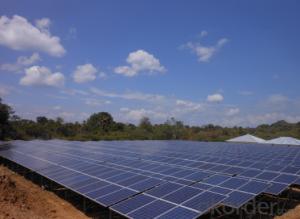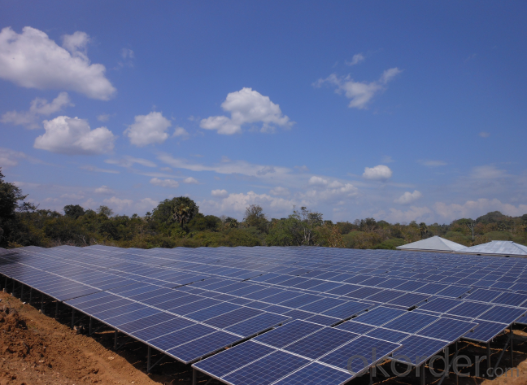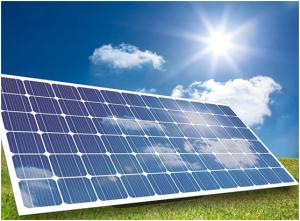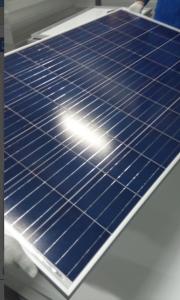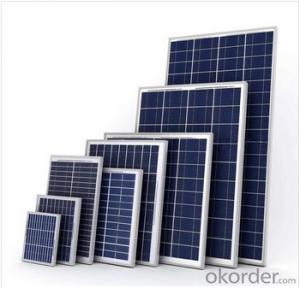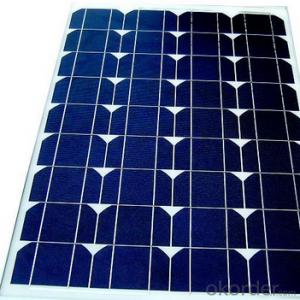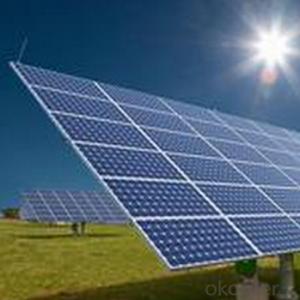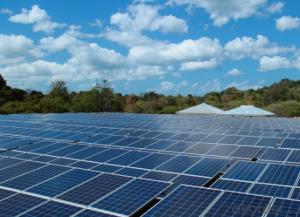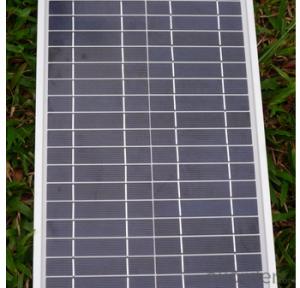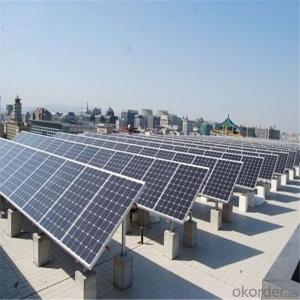High Power Poly Solar Panel/Module for Housing - ICE 32
- Loading Port:
- China main port
- Payment Terms:
- TT OR LC
- Min Order Qty:
- 200 watt
- Supply Capability:
- 50000 watt/month
OKorder Service Pledge
OKorder Financial Service
You Might Also Like
Instruction
Format : 156 mm × 156 mm ± 0.5 mm
Thickness: 210 μm ±40 μm
Feature
1. High efficiency and High power.
2. Long-term electrical stability.
3. Lowest price and Fastest delivery.
4. Good quality and best service.
5. Bulk supply
Images

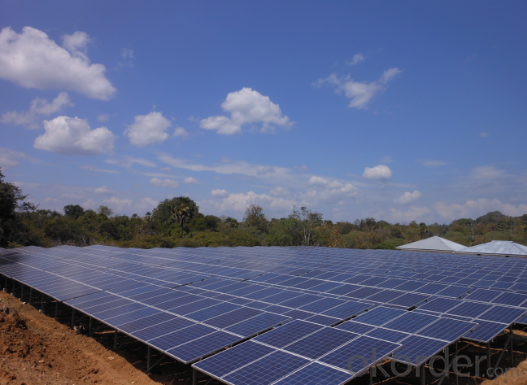
Specification
Electrical Characteristic of Mono Solar Cells
Model Type | |
Peak Power-Pmax(W) | 185 |
Open Circuit Voltage-Voc(V) | 44.2 |
Maximum Power Voltage-Vmp(V) | 36 |
Short Circuit Current-Isc(A) | 5.4 |
Maximum Power Current-Imp(A) | 5 |
Maximum System Voltage | 1000V DC |
Maximum Series Fuse Rating | 10A |
Power Tolerance | -1~+3% |
Temperature Coefficients of Pmax | -0.45%/℃ |
Temperature Coefficients of Voc | -0.348%/℃ |
Temperature Coefficients of Isc | 0.031%/℃ |
Nominal Operating Cell Temperature | 44.5±2℃ |
Standard Testing Condition(STC) | Irradiance:1000W/m²;Temperature:25℃;AM=1.5 |
Qualification Test Parameters | |
Operating Temperature | -40℃~+85℃ |
Storage Temperature | -40℃~+85℃ |
Pressure Bearing | ≥5400Pascal/m² |
Wind Bearing | ≥5400Pascal/m² |
Mechanical Characteristics | |
Cell Size | Mono 125*125mm±0.5 |
No.of Cells | 72pcs(6*12) |
Dimension | 1580*808*40mm |
Weight | 15.5Kg |
Glass | 3.2mm High Transmission,Low Iron |
Frame | Anodized Aluminum Alloy |
Junction Box | IP65Rated |
Internal Diodes | 3 Bypass Diodes |
Cable | 1*4.0mm² Length 900mm |
FAQ
We have organized several common questions for our clients,may help you sincerely:
1. What’s price per watt?
A: It’s depends on the quantity, delivery date and payment terms of the order. We can talk further about the detail price issue. Our products is high quality with lower price level.
2. Can you tell me the parameter of your solar cells?
We have different series of cells with different power output, both from c-si to a-si. Please take our specification sheet for your reference.
3. How do you pack your products?
We have rich experience on how to pack the panels to make sure the safety on shipment when it arrives at the destination.
- Q: Can solar panels be installed on an RV or camper?
- Yes, solar panels can be installed on an RV or camper. This allows you to harness the power of the sun to generate electricity and charge your batteries, making your RV or camper more self-sufficient and reducing reliance on traditional power sources.
- Q: How do solar panels affect the roof's lifespan?
- Solar panels can actually extend the lifespan of a roof. They act as a protective layer, shielding the roof from harsh weather conditions and reducing direct exposure to sunlight. This helps to prevent deterioration and can ultimately prolong the roof's lifespan.
- Q: Can you please tell me how much a solar panel costs?Please back up your info with a website.
- If okorder /.. Low-cost crystalline panel manufacturers such as Suntech are believed to have costs in the $.50/watt range today - making it $300 for a 200-watt panel. That doesn't mean that one can buy a panel for that price, of course. If you mean a DIY panel from purchased solar cells, the cost would be closer to $360 for an equivalent-powered panel, not counting the price of the frame, and the labor. A homebuilt panel would not stand up to decades of weather unless one spent even more on the frame. And since such a panel would not have safety certification, it could not legally be connected to the grid in most places. If you meant a water heating panel, please update or post another question - I'm sure people will chime in.
- Q: The battery is 9ah and the solar panel is 20w
- despite the statements to the contrary, using a solar panel to charge a battery is not rocket science. first lets look at you panel. panels normally have a spec for open circuit voltage (probably 20 volts for yours) operating power (4.4 volts at .4 amps is usual for 20 watt panel) and short circuit current (probably 2 amps in your case). if this panel is connected to a 2 volt battery, it will develop 20 watts of charge current in full sun. if this panel is connected to a 6 volt battery, it will work closer to the short circuit current or about .8 amps. doing the math this is a 7.2v x ,8= 3 watt charger for 6 volt batteries. while it is less efficient than when working at 2 volts, it will still work pretty good and no regulator is needed if you remember to disconnect the panel after 5 hours of full sun. if you want to walk away and have it run automatically, then you will need to find a 6 volt charge controller.
- Q: So I want to go completely solar. Do I need the connected solar panels alone for after sundown hours; Do I need something else in order to have energy to run my entire house throughout the night?In other words do solar panels store the energy for after sun-down or do I need other devices to store the energy?
- Unless okorder
- Q: Got a small project here in a remote location. There is to be a 2 volt deep cycle battery, the equipment to be powered from battery and solar panel to charge battery. The 2 volt battery puts out 55 AH. the max constant power draw from the equipment to be powered is 7.9 watts. Will a 30 watt panel at 2 volts be enough to run this system during sunlight and charge the battery for the equipment to run overnight?And, at 55 AH, how long can I keep a constant draw of 7.9 watts without a recharge?Thanks to all the input!
- Will a 30 watt panel at 2 volts be enough to run this system during sunlight and charge the battery for the equipment to run overnight? Maybe theoretically, but you're going to have very little margin for losses and clouds. I'll bet it has very little power when cloudy. 7.9/30 = 0.26. So at 00% efficiency, you'd need it to be charging more than 25% of each 24 hour period. In a summer with long days and a climate with few clouds, you might make it. But I think you're very close to the edge. And, at 55 AH, how long can I keep a constant draw of 7.9 watts without a recharge? For an ideal battery: time = Q V / P time = 55 A h * 2V / 7.9W time = 83 hours So you've got pretty good margin on your battery.
- Q: Can solar panels be installed on research facilities or laboratories?
- Yes, solar panels can be installed on research facilities or laboratories. In fact, many research facilities and laboratories have started to adopt solar energy to reduce their carbon footprint and dependence on traditional energy sources. Solar panels can be installed on rooftops or open spaces adjacent to the facility, providing clean and sustainable energy to power various equipment and operations. Additionally, the installation of solar panels on research facilities can serve as a demonstration of renewable energy technologies and encourage further adoption within the scientific community.
- Q: How do I hook up solar panels to my home
- Kinetic energy of the solar photons in the 'light', hit the surface of the compound, displacing the molecular components in it, creating a flow of energy carrying corpuscles down the wire. These - collected at the end of this circuit - produce energy sufficient to cause movement via the magnetic fields they cross on the either natural or electrically induced magnets they pass through. Basic principles to have in mind, is that these panels only produce ONE type of energy: direct. From one side (+) to another (-), and you must follow this principle when connecting. My suggestion is find the supplier and get instructions. They usually have detailed information. In order to hook up this panel, you must follow instructions.
- Q: How much Electricity does a standard Solar panel producein terms of Watts and in terms of Units( i.e. electricity meter attached in our House)If I have 20 Solar panels and an inverter , how much electricity will I Be able to harness and store (state that in terms of volts)Can I run Arefridgerator, Iron, Heaters, Plasma T.V. and other high Electricity Consuming Devices.
- Take a look on OKorder at some of the books on how to design solar energy systems. It is a bit more complicated than you might expect. I'm not sure what you consider to be a standard solar panel, but the 3' ones I have produce about 5 watts of power in full sunlight. Put simply, you need to convert the power from the solar cells (variable voltage) into a constant voltage usable for charging a batteries. Most of the low cost modules for this purpose can't handle more than about 00 watts. Larger systems are available that handle thousands of watts but they are quite pricey. Since you can't take out more than you put into your battery system, you can calculate about how long you can run a high-current appliance based upon its wattage rating, that of the battery system (adjusted for loss of converting to AC), and the charging system.
- Q: How many solar panels have ah?
- However, crystalline silicon (monocrystalline silicon and polysilicon) in the weak light is basically no current generation, amorphous silicon weak light type (in low light energy is rarely). So a comprehensive view, it is appropriate to use monocrystalline silicon or polycrystalline silicon solar cell materials. Second, the choice of solar cells 1, we buy solar cells, the focus is on the power of solar cells, in general, the solar panel power is proportional to the area of ??solar chips.
Send your message to us
High Power Poly Solar Panel/Module for Housing - ICE 32
- Loading Port:
- China main port
- Payment Terms:
- TT OR LC
- Min Order Qty:
- 200 watt
- Supply Capability:
- 50000 watt/month
OKorder Service Pledge
OKorder Financial Service
Similar products
Hot products
Hot Searches
Related keywords
